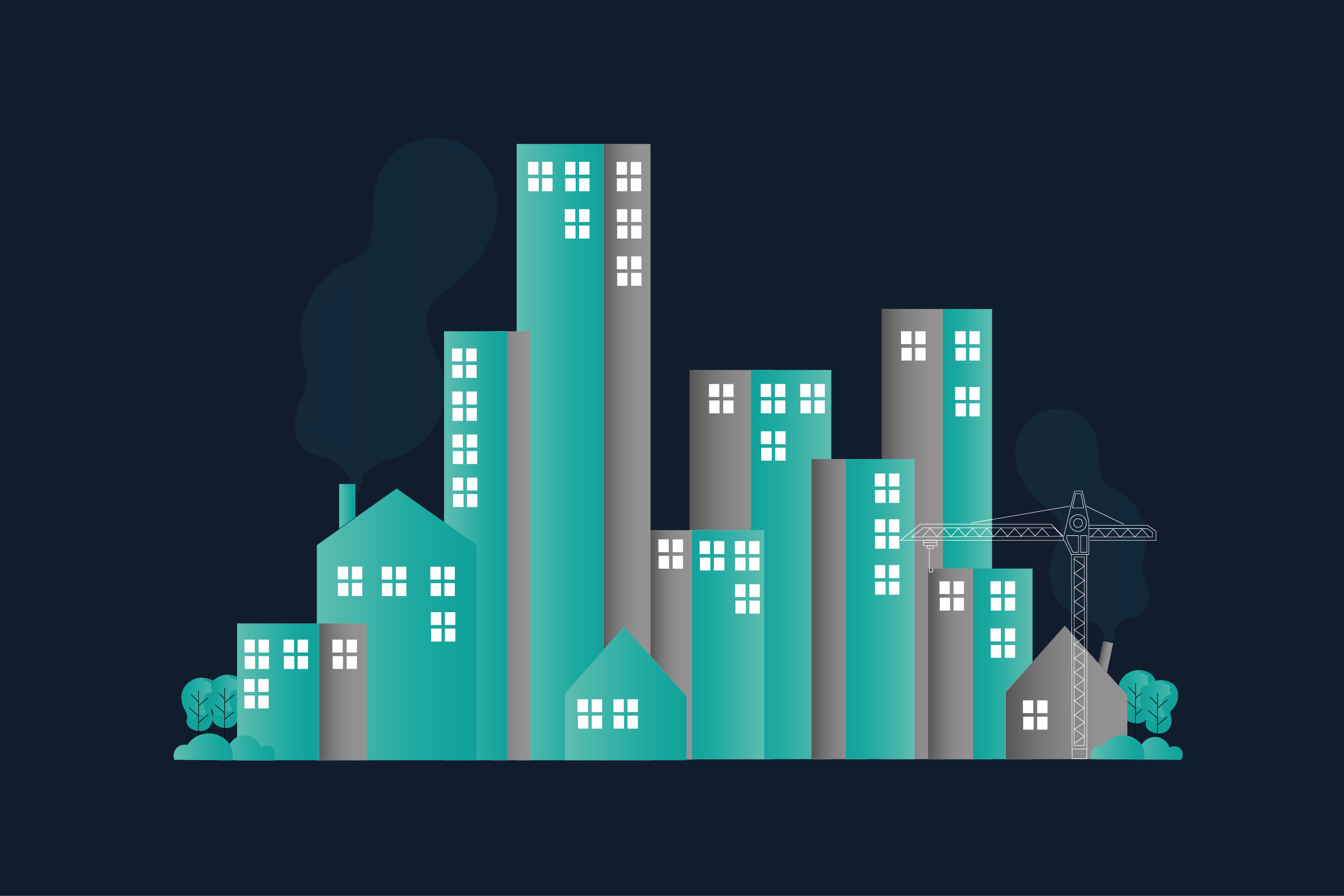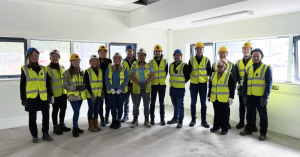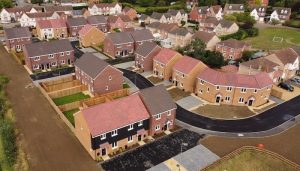The construction industry is responsible for a staggering 36% of global energy use with the UK alone accountable for 47% of carbon dioxide emissions. It is therefore unsurprising, that this huge industry has a big impact on our environment. With the mass production of construction materials being the largest contributor to CO2 emissions within the construction process, and increasingly depleted non-renewable natural resources, there has been mounting pressure on contractors to find a greener way to build for the future.
The Government is the largest UK construction client, responsible for commissioning over 40% of builds. To ensure the construction industry takes positive steps towards reducing their impact on the environment they have set out several socioeconomic and environmental sustainability targets which must be adhered to in order to successfully tender for contracts. These include a focus on using renewable and recyclable resources, the reduction of waste and energy consumption, protecting the natural environment and building a non-toxic, healthy, and high-quality environment. These key principles form the building blocks of sustainable construction.
In this blog, Tender Coordinator Paul Burton, with commentary from contributors at Elementa Consulting, Arcadis and Carbon Plan Engineering, will explore exactly what sustainable construction is and why it is of great importance moving forward.
Do Sustainable Construction Methodologies Matter?
A rising population generates a rising demand for housing and commercial buildings for employment and community infrastructure. There are obvious concerns about building on green belt land and the destruction of natural wildlife habitats, but there is growing concern about the energy use and CO2 emissions involved in the construction processes and the disposal of hazardous waste by-products. Industrial machinery burns through the dwindling reserves of fossil-fuels, mining for raw materials can result in water table pollution and the manufacture and shipping of materials produces obscene CO2 emissions, with the production of concrete singularly contributing 1.5% towards the total UK CO2 emissions. The industry currently uses over 90 million tonnes of concrete in a typical year, a figure that is set to rise. According to the United Nations Environment Programme (UNEP), the increased construction activities and urbanisation of our natural surroundings will increase waste to such an extent that up to 70% of natural resources and on land wildlife habitats will be eradicated by 2032.
Alan Calcott, Carbon Plan Engineering “Undertaking development projects in a sustainable way is critical if the UK is to remain a competitive and attractive place in which to do business. The Government, and in particular the Public Sector, has a key role to play by showing leadership in the delivery of Net Zero buildings. This is epitomised by the Public Sector Decarbonisation scheme which provided £1Bn to the public sector to move away from fossil fuelled heat. The Net Zero Carbon buildings commitment and Climate Change Platform supported by the UKGBC has commitments from over 30 of the UKs largest developers to push forward the low carbon agenda and ongoing work by the UK GBC and others on developing a framework for Net Zero signposts the direction for the entire sector. Carbon Plan Engineering are at the forefront of this work in both the public and private sector, designing buildings which are low carbon and Net Zero enabled”.
What Are The Benefits Of Adopting A Sustainable Construction Approach?
So why should you convert red bricks to green bricks and ensure sustainable construction? It is undeniable that one of the most significant benefits to adopting a sustainable construction approach is that it is better for the environment. But there are other benefits too. Greener buildings mean lower operating costs. Research by the European Commission into the global savings and benefits of using more sustainable technologies, predicts a potential global net saving of €410 billion per year by 2030. These savings on energy bills for consumers make green or eco buildings increasingly popular. Contractors can expect to deliver direct savings too, reducing waste will reduce waste collection charges and more efficient vehicles and machinery will reduce fuel costs. Design and planning are key to avoid fines from the Environment Agency for failing to manage environmental and social risks. Individual construction companies were fined between £13,000 – £40,000 in 2002 for pollution offences. Sustainability is the foundation of future profit, as commitment to better environmental and economical best practices can boost your reputation and secure more business by demonstrating a corporate social responsibility. The growing demand for contractors to have an awareness of their social and environmental impact on communities can mean that if your company ensures suppliers throughout the supply chain can demonstrate dedication to reducing their carbon footprint, this can promote higher chances of success and give you an extra advantage over competitors, in addition to just price and SLA’s, when it comes to securing contracts. The highest level of industry standard for validating your commitment to Environmental Management Systems is the UKAS accreditation of the ISO 14001 certification, which clearly defines how a company has implemented a series of procedures to achieve their goals to minimise their impact on the environment.
Simon Ebbatson, Principal, Elementa Consulting “As professionals in real estate, we all have a responsibility to drive positive change in attacking the climate crisis that as an industry we have now all created. We now play a crucial role in the fight against climate change. There is little doubt that more sustainable design delivers better overall quality buildings for occupants. To deliver on this we need think holistically and embrace initiatives like LETI (London Energy Transformation initiative) to work collaboratively and share knowledge across the industry at every stage of the design and construction process.”
What Is A BREEAM Certification?
The consequences for climate change and environmental impact as the construction industry grows are so alarming that sustainable construction is indisputably of paramount importance. Increasingly, contractors will look to adopt more sustainable methods from the start of the design process to sourcing materials through to the build stage itself. BREEAM (BRE Environmental Assessment Method) is a system for assessing and certifying the environmental performance of buildings both new and existing. EcoHomes is a version of BREEAM designed specifically for residential properties. Designers can use BREEAM and EcoHomes in addition to drawing on their own knowledge and expertise in environmental sustainability, as tools to improve the performance of their building’s design. CEEQUAL is a similar application for assessing civil engineering projects, incorporating a Sustainability Checklist for Developments, a tool based on BREEAM, that can be used to assess the sustainability performance of entire developments. The Better Buildings Partnership offers a toolkit for Green Building Management, designed to help businesses and other users implement the right team with a shared set of values and goals to promote sustainable use.
The One Angle Square building in Manchester received the highest BREEAM ranking, making it one of the most sustainable buildings in the UK. This office building uses rainwater collection and water recycling as well as solar building design to significantly reduce its environmental impact. Born out of the increased demand for sustainable buildings is Passivhaus, a building design standard which focusses on lowering the buildings innate demand for energy primarily through a highly insulated and air-tight façade with high efficiency heat recovery ventilation. In so doing this, the building has ultra-low energy consumption, reducing the building’s ecological footprint and the occupant’s energy bills. Whilst this concept started out in residential builds, it is now seeing popularity in business and education projects.
With Increased Prices Can We Justify The Cost?
Achieving sustainable construction practices has its challenges, with cost being the number one obstacle. There are concerns that sustainable materials and processes increase the initial build costs, a difficult hurdle to overcome when there is pressure to reduce costs. But with an increase in demand for more sustainable and more environmentally friendly buildings, with clients wanting better quality and better energy performance from buildings, is the return on investment to adopt a more sustainable approach a price worth paying for the construction industry?
Georgie Thompson, Planner and Client Development Coordinator, Arcadis “It’s our responsibility to create a sustainable human landscape in which future generations will live and work. The huge energy, carbon and waste impacts construction have are well documented, so on the flip side positive changes we make in the construction industry have a positive contribution for all of society. What we do now has a lasting impact and legacy that will stretch beyond all our lifetimes. It is vital that we consider the setting and whole life of our buildings and infrastructure, so they are constructed with sustainable methodologies, materials and designed so they can be used, operated and decommissioned sustainably. From a company perspective social value is increasingly the measure of success, future funding and investment opportunities are dependent on the sustainable business case, performance and outcomes of a project. To have a high performing workforce you want the best people and with the talent pool being ever more conscious of sustainable practices, it is essential you demonstrate these values to attract and keep them. We know a sustainable future is the only future, so our challenge is to make sustainable construction the only construction”.

Tom Woolley, an accomplished Key Account Manager overseeing the East Midlands and East of England at Procure Partnerships Framework, brings a wealth of expertise honed over more than 15 years in the public and third sectors. In his pivotal role, Tom supports public sector clients in procuring diverse construction schemes and enlisting the services of expert consultants.



